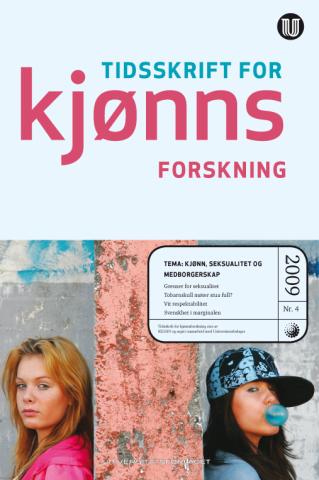Gender, sexuality and citizenship

Articles
Wencke Mühleisen, Åse Røthing amd Stine Helena Bang Svendsen:
The borders of sexuality. Norwegian conceptions of sexuality in immigrant legislation
What are the roles of conceptions of sexuality in the political production of citizenship? In this article we consider how Norwegian sexual politics, in a broad sense, contributes to integration and exclusion concerning citizenship. Based on the Government-initiated course for first-time parents, Living together, and policy documents concerning pro forma marriage and asylum applications on the grounds of homosexuality, we discuss how gendered and racialised conceptions of sexuality come into play in constructions of normative "Norwegian sexuality", as well as its "Others". Finally, we argue that certain understandings of sexuality are employed in the construction of Norwegian nationality in these processes of inclusion and exclusion.
Keywords: Citizenship, sexuality, pro forma marriage, couple counselling, immigration, sexual orientation, refugees
Guro Korsnes Kristensen:
A full dozen or two-child families? Immigrant birth rates in Norwegian public discourse
Today’s Norwegian women give birth to an average of 1.9 children. Immigrants have slightly different reproductive patterns from the general population. This article examines how these differences are addressed in Norwegian public life. I argue that it is possible to identify constructions of a "Norwegian" community, and potential exclusion, ranking and hierarchization in relation to it in public discourses on reproduction.
Keywords: Nation, immigration, reproduction, gender equality, public discourse, post colonialism
Catrin Lundström:
White respectability. The Swedish nation’s gender symbolism and young women’s cultural practices
This article engages with social and cultural constructions of Swedishness from a perspective that highlights the intersections of gender, sexuality and race. It argues that racialized discourses around heterosexuality constitute an important aspect of the notion of the nation and its boundaries of belonging. Empirically, the study is based on interviews with 29 young women of Latin American descent, born and/or raised in Sweden. By considering ideas of nation, race, gender and sexuality as being intertwined, complex processes of inclusion and exclusion are illuminated. While the young women experience exclusion from the Swedish narrative of whiteness, they define themselves as Swedes by culturally associating with sexual liberty: a central part of the idea of "a Swedish sexuality". In this way, they simultaneously distance themselves from virginity or abstinence, a practice associated with young Muslim women, and in a broadersense, with the notion of "immigrants". Since non-white women are not defined as symbolic to the nation in the same way as white women are, however, it is argued that they, as young Latin women, do not embody Swedishness and the kind of respectability inherited in the construction of whiteness. Thus, by exploring national identity through interconnected practices, the article argues that the often discussed and criticized dichotomy of "Swedes" and "immigrants" appears even more complex when gender and sexuality are introduced into the analysis.
Keywords: Sweden, national belonging, racialisation, sexuality, whiteness, femininity, respectability, young women
Maria Bäckman:
Swedishness on the fringes – a concept of fellowship
The subject of the article is the "Swedish girl" as a representation of sexual availability and lack of respectability. It uses a lengthy ethnographic fieldwork in a multi-ethnic suburb of Stockholm to pose questions about local Swedishness, imagined communities and white respectability. Several researchers have highlighted how "Swedishness" tends to be a normality that is so uncontested that it cannot even be seen. Likewise, it is often pointed out that it is the majority society’s self-perception that is associated with the normal and the ideal. This article suggests that there are also contexts that express something else: where the dominance relations are not very clear. In some cases the "Swedish" can be just as remarkable, visible and deviating as the "non-Swedish".
A number of examples underline the general ambivalence that surrounds "local talk" about both sexuality and Swedishness. On the one hand, sexuality is a field where indicating distance from the emancipated or loose-living "Swedish girl" can be strategic. On the other hand, an active sexuality can also be an indication that you are emancipated, modern and equal. What complicates the situation of Swedish young people even further is that Swedes also symbolize the suburb’s "alien other". Or, to use Zygmunt Bauman’s formulation, that it is possible to regard them as "strangers within".
The article is an adaptation of the author’s recently published work, Miljonsvennar. Omstridda platser och identiteter (Million Programme Ethnic Swedes. Disputed places and identities.), Bäckman 2009.
Keywords: Sweden, sexuality, imagined communities, racialisation, whiteness, strangers within